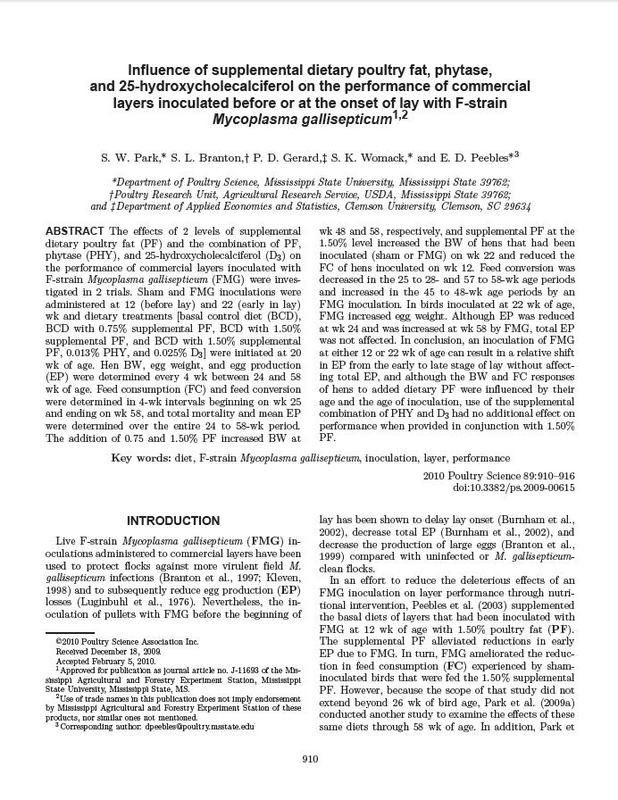Influence of supplemental dietary poultry fat, phytase, and 25-hydroxycholecalciferol on the performance of commercial layers inoculated before or at the onset of lay with F-strain Mycoplasma gallisepticum
Title
Influence of supplemental dietary poultry fat, phytase, and 25-hydroxycholecalciferol on the performance of commercial layers inoculated before or at the onset of lay with F-strain Mycoplasma gallisepticum
Date
Subject
Excerpt
The effects of 2 levels of supplemental dietary poultry fat (PF) and the combination of PF, phytase (PHY), and 25-hydroxycholecalciferol (D(3)) on the performance of commercial layers inoculated with F-strain Mycoplasma gallisepticum (FMG) were investigated in 2 trials. Sham and FMG inoculations were administered at 12 (before lay) and 22 (early in lay) wk and dietary treatments [basal control diet (BCD), BCD with 0.75% supplemental PF, BCD with 1.50% supplemental PF, and BCD with 1.50% supplemental PF, 0.013% PHY, and 0.025% D(3)] were initiated at 20 wk of age. Hen BW, egg weight, and egg production (EP) were determined every 4 wk between 24 and 58 wk of age. Feed consumption (FC) and feed conversion were determined in 4-wk intervals beginning on wk 25 and ending on wk 58, and total mortality and mean EP were determined over the entire 24 to 58-wk period. The addition of 0.75 and 1.50% PF increased BW at wk 48 and 58, respectively, and supplemental PF at the 1.50% level increased the BW of hens that had been inoculated (sham or FMG) on wk 22 and reduced the FC of hens inoculated on wk 12. Feed conversion was decreased in the 25 to 28- and 57 to 58-wk age periods and increased in the 45 to 48-wk age periods by an FMG inoculation. In birds inoculated at 22 wk of age, FMG increased egg weight. Although EP was reduced at wk 24 and was increased at wk 58 by FMG, total EP was not affected. In conclusion, an inoculation of FMG at either 12 or 22 wk of age can result in a relative shift in EP from the early to late stage of lay without affecting total EP, and although the BW and FC responses of hens to added dietary PF were influenced by their age and the age of inoculation, use of the supplemental combination of PHY and D(3) had no additional effect on performance when provided in conjunction with 1.50% PF.
Relation
Poultry Science
Volume 89, Number 5
pp. 910-916
 An official website of the United States government.
An official website of the United States government.


